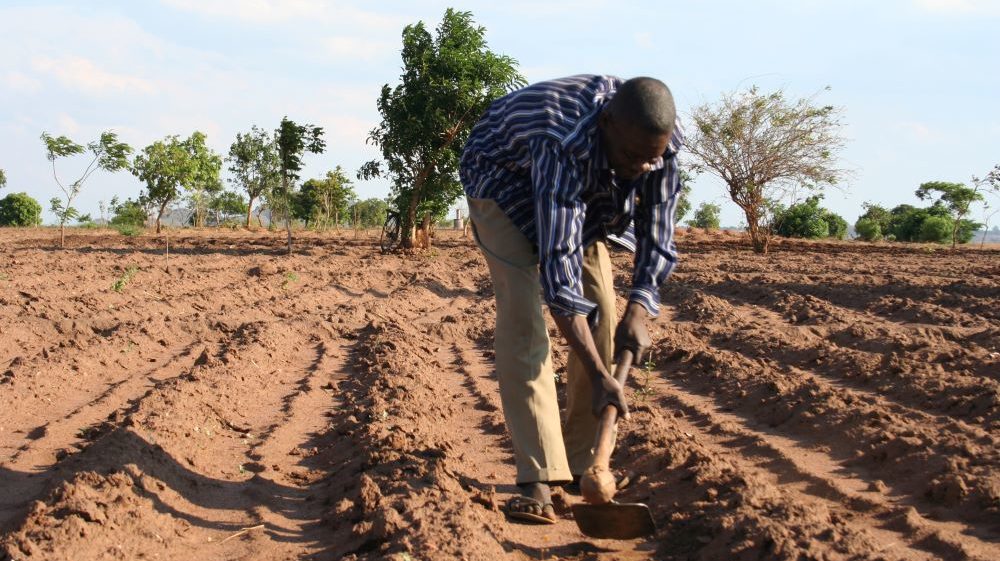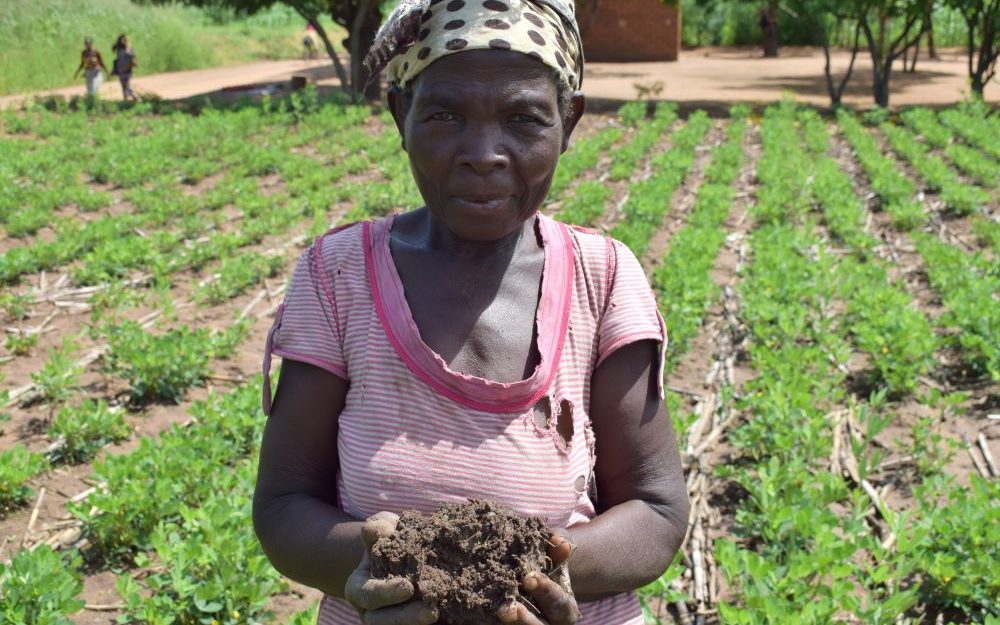As the climate warms, extreme weather of droughts, floods and high temperatures are affecting agriculture, threatening food security in Africa.
Smallholder farmers are barely able to put food on the table as they work on exhausted soils that only produce poor crop yields, if anything. Erratic and excessive rainfall patterns have also contributed to reduced crop production.

Scientists are promoting climate smart agriculture (CSA) approaches that are helping smallholder farmers tackle poor crop yields, degraded soils, and low soil fertility.
Farming the smart way
Conservation Agriculture (CA) is one approach under climate smart agriculture that is taking root across Africa. It is enabling smallholder farmers to produce crops closer to nature by avoiding excessive soil tillage, abandon burning or removing of crop residues and practice crop diversification. The combined use of those principles maintains crop productivity, stabilizes crop yields and in the longer run also builds soil quality and health.
In particular, the application of CA principles preserves soil moisture and enhances soil fertility through the application of nutrients to the soil such as manure and fertilizer. Other complimentary practices such as improved seed and weed control methods, and mechanization improve the efficiency of farming and save on farm labour.
Elufe Chipande from Zomba District in Southern Malawi is one of the early adopters of conservation agriculture. She testifies that shifting from conventional agriculture to the CA approach has transformed her farming.
Chipande (62) who has been practising CA for the past 14 years used to harvest up to 2 tonnes of maize per hectare using only improved maize seed.
Shifting towards CA techniques has quadrupled her harvest to 8 tonnes per hectare and she now has excess grain to sell to increase her income while ensuring her family has enough to eat up to the next farming season. The secret, she says, is in the promotion of soil health.
“Crops grow well if the soil is healthy, so soil health is important,” emphasized Chipande.
“I have had high yields in maize and other crops planted using CA.”

From the proceeds of selling excess harvest, Chipande has been able to invest in property. She built five houses from which she receives rentals and is able to pay school fees for her children while meeting other household needs. Furthermore, the practise has reduced her labour need in terms of land preparation as the traditional land preparation practice, creating annual planting ridges, involves between 25-35 labour days per hectare, whereas planting with direct seeding tools under CA reduces this to a fraction of 5-7 days only.
“I also have lots of time to rest,” Chipande quipped, which is a social benefit that should not be underestimated.
Today, CA is practised on sandy, clay and even marginal soils across the world by famers but on only smaller land holdings less than half a hectare in many parts of Africa and India. In other areas, fields are much larger and usually average more than a thousand hectares of commercial farm land in Argentina, Brazil, Australia, South Africa and the United States. Globally, approximately 180M hectares are cultivated under CA.
Farmer, George Sande (71) and his wife, Monica, from Kapile Village in Zomba District in Central Malawi understand the importance of enhancing soil fertility in farming. They use maize stalk in mulching their field to reduce soil moisture loss while improving its fertility.
“Ever since I started implementing this (CA) in my maize yields have increased,” Sande testified, noting that shifting from harvesting less in one hectare to doubling the yield has ensured food security for his family. This enormous yield benefit was triggered not only by the use of CA principles but also by key management practices applied such as: timely planting; optimal weed control; adequate fertilization and row planting of maize at optimal plant spacing amongst others.
“The hustle of getting maize stalks from other gardens when your own stalks have been used by others especially for animal feed is a problem,” Sande said, which is a struggle of all farmers around the world who want to keep their soils covered.
Mphatso Gama, Principal Agricultural Officer and a CA expert in the Machinga Agricultural Development Division of the Ministry of Agriculture and Food Security in Malawi, says in applying CA principles farmers have been able to improve soil health, especially the organic matter content.
Machinga ADD has been collaborating with the International Maize and Wheat Improvement Center (CIMMYT) in a number of projects in conducting farmer managed long term research trials for over 15 years.
Many farmers in Malawi had traditionally used the ridge and farrow systems where they plant crops in ridges but on adopting CA, which means planting on the flat with a pointed stick, they have been able to compare the impacts of the two methods when they harvest crops.

“Farmers were not aware of soil health because there was previously no practise that could improve soil fertility. Where farmers have no knowledge, it is difficult to change to something else,” said Gama. “Farmers started noting a decline in their crop yields and knew something was wrong and they gradually shifted to conservation agriculture”.
“We are happy that farmers have realised that the CA approach is the way to go, bearing in mind that most of our soils in Malawi are degraded and we need to bring back the soil fertility into our fields for us to maintain yields and increase them,” said Gama.
For Daniel Mtokoma (23) a young farmer from Zomba District in Malawi, results of practising CA for the last two years have been encouraging as he has seen crops growing better and yields increasing.
“The technology minimises labour and cost because there is no tilling and no hand weeding,” Mtokoma said, describing CA as the best technology to deal with the impacts of climate change such as drought because farmers are able to harvest a crop even when growing conditions are poor.
Securing soil health for food security
According to the FAO, 33 percent of the Earth’s soils are already degraded as a result of the combination of erosion, overgrazing, nitrogen loss and deforestation which threatens humankind moving beyond planetary boundaries.
Soil health was a key focus of a recent webinar on “Improving soil health through climate-smart agriculture: A key to resilient farming systems and food security in sub-Saharan Africa” hosted by AFRICAP.
The seminar focused on recent AFRICAP research aimed at informing context-specific CSA recommendations and policies for resilient agriculture and food security in sub-Saharan Africa.
Prof. Andy Dougill, who gave an overview of climate-smart agriculture and how it can be a route to building back resilience into African food systems, highlighted the interconnections between land management and climate challenges.
Thirze Hermans, a PhD Researcher, at the University of Leeds working on Conservation Agriculture scaling in Malawi in collaboration with CIMMYT offered an in-depth explanation of integrated soil health assessments and how they combine soil science and local experience for a deeper understanding of land management decision-making.
Through case studies from Malawi and Tanzania, as well as research on soil health indicators, Samuel Eze, GCRF-AFRICAP Research Fellow, Soil Science of African Agricultural Systems at the University of Leeds, explained how CSA delivers benefits to key soil physical and chemical parameters, and for whom.
Speaking at the webinar, CIMMYT Principal Cropping Systems Agronomist, Dr. Christian Thierfelder explained that CA as a package was not widely adopted across Africa despite its lauded benefits because of poor understanding of the approach by farmers and lack of appropriate inputs and machinery.

Furthermore inconsistent messaging and definitions, time lag in yield benefits, lack of political, cultural values and norms were other constraints in CA adoption.
“CA may be initially more knowledge intensive than traditional tillage-based agriculture systems but once the concept is mastered by smallholders, which usually happens after 2-5 years of experimentation, yields become more stable and soil fertility improves”, Thierfelder says.
Thierfelder concluded that increased resilience against climate stress will be the strongest driver for change as continued farming the traditional way will only increase soil fertility decline and the negative impacts of climate change, leading to food insecurity and poverty.
